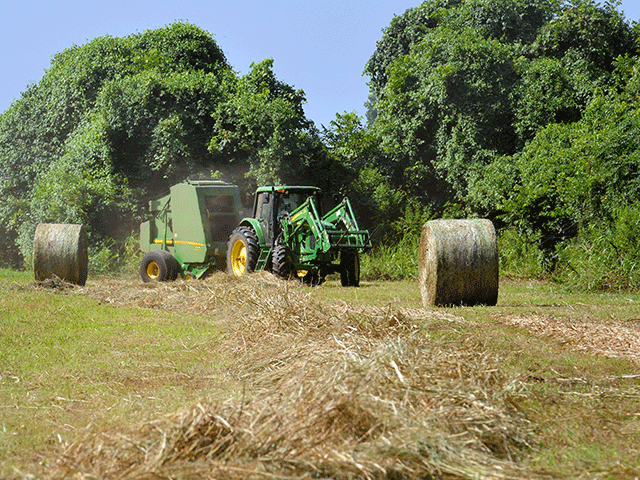Complete Hay Equipment Maintenance Now
University of Missouri Extension Offers Tips for Smooth Hay Baling Season
OMAHA (DTN) -- Forages are growing and hay producers are preparing for yet another hay harvesting season. Before the cutting, raking and baling begins, make sure your hay equipment is ready for the season.
A simple walk around and examination of machinery before the haying season can lead to fewer in-season breakdowns. The University of Missouri Extension has a list of some of the steps to take before putting hay on the ground.
Here is their list:
-- Clean out old hay. If you haven't already, clear out any leftover hay from last season to reduce the risk of fire once haying begins.
-- Grease haying equipment. It's an essential part of any maintenance program to grease equipment. But don't overdo it as excess grease can be harmful. Stop putting in grease once it starts to become visible.
P[L1] D[0x0] M[300x250] OOP[F] ADUNIT[] T[]
-- Replace worn belts on hay balers. Check belts for excessive wear or holes and inspect splices to ensure they are in good condition. A worn splice can cause the belt to split and lead to inconsistent bale tension.
-- Change broken teeth or blades now. To ensure a consistent cut, replace any dull or broken blades or teeth. Many mowers and swathers have replacement or reversible components, so you may be able to flip them before swapping them out entirely.
-- Swap damaged tines or teeth. Rakes, tedders, balers and swathers all have various types of tines or teeth to help move and accumulate forage. If any are broken or bent, replace them before the season.
-- Test the bearings of hay equipment. A bad bearing can cause excessive heat and pose a major fire risk, making it vital to check them all. One way to do this is to bale 15 to 20 bales and then check to see if any of the bearings are overly hot.
-- Examine the fluids in hay equipment. If you use a tractor or any self-propelled equipment for haying, check liquids like oil, hydraulic fluids and coolant to make sure all are at the suggested levels.
-- Check the tire pressure and the tread of the tires. Make sure tires are in good condition with recommended levels of air pressure, which can help with maintaining cutting heights.
-- Investigate the electrical components of hay equipment. Newer equipment has more electronics, so take some time to verify that all wiring works. During the off-season, rodents could damage the wiring of equipment while it was in storage.
The report also suggests hay producers stock up on spare parts. Order some additional teeth, blades, tines and belts. This will assure a minor breakdown can be fixed quickly. Also, keep enough twine and net wrap on hand to get started with the first cutting of hay.
In addition, don't forget about safety equipment during hay season. Keep fire extinguishers easily accessible. Make sure they haven't expired and have them inspected if needed -- a little precaution can go a long way in an emergency.
Performing preseason maintenance and stocking up on essential parts can be the difference between experiencing a smooth haying season and racing against the rain. Take the time now to prepare, so when the storm clouds roll in, you are ready, according to the report.
Russ Quinn can be reached at Russ.Quinn@dtn.com
Follow him on social platform X @RussQuinnDTN
(c) Copyright 2025 DTN, LLC. All rights reserved.



